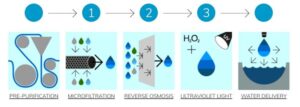Is “Recycled” Water a Total Turn Off?
Across the country, drinking and wastewater utilities have been exploring alternative strategies to protect the resource we really can’t live without – water. Severe weather events, increased drought projections and aging infrastructure are accelerating the need to identify swift and innovative strategies to ensure we don’t lose access to the Earth’s most precious resource. So, what can we do about it?
Well, the answer might be more straightforward than you thought. Ever heard of recycled water?
Back in the 1990s, regions in Southern California like the San Gabriel Valley and the City of Los Angeles, started developing programs to use recycled water for groundwater replenishment. One of the outcomes of this noble effort was an unfortunate phrase that would significantly hinder the public’s uptake of this incredibly effective water management strategy. That phrase was “toilet to tap.”
Since then, water experts and managers have carried out a generally successful campaign to discontinue this gag-worthy phrase, but they then realized that the replacement terminology might not be any better. In studies from around the world, “disgust” was the most commonly cited reaction to the idea of recycled water and despite a diligent effort to remove references to toilets and human waste from the narrative, consumers are still very alarmed by the idea that they might be drinking “poop water.”
So, how the heck do you recycle water?
Recycled water systems vary from country to country and even region to region. In Orange County, CA for example, the recycled water system uses a three-step process consisting of microfiltration, reverse osmosis and ultraviolet light with hydrogen peroxide. From there, the Groundwater Replenishment Systems (GWRS) water is piped about 13 miles through several cities across the county to recharge the groundwater basins. The purified water, which meets or exceeds all state and federal standards, is then stored in the Orange County Groundwater Basin and 30 million gallons of this recycled or purified water is then pumped into wells that protect the county’s water supply from seawater intrusion. This is the world’s largest water recycling system of its kind and provides about 70 percent of the potable water needs to 2.4 million residents.

Only 40 miles up the road, the Los Angeles Department of Water and Power is developing the state’s first approved direct potable water reuse project. This proof-of-concept effort is just one part of the city’s plan to recycle 100% of its wastewater by 2035. The project will require a local water reclamation plant be converted into an advanced water purification facility that produces clean drinking water. This purified drinking water will then be injected into the aquifers existing under the southern part of LA County and the San Fernando Valley. Eventually, after phasing in the various steps required to ensure a safe and effective process, the water will be added directly to LA’s drinking water system.
Recycled water is not new, btw.
Recycling is the whole reason water has existed on the planet for so long. The natural water cycle or hydrologic cycle involves a continuous circulation of water in the Earth-atmosphere system. Earth’s water is constantly changing forms, between liquid to solid, and then to gas, and on and on… This means the same water molecules sitting in your cup of coffee this morning might have once been dinosaur feces. (Yep.)
How do we get people to accept it?
A water utility’s primary objective is to ensure that clean, safe, and affordable water is available and accessible to all customers for drinking, bathing and cooking, as well as for general hygiene and recreation. Recycled water is one of the best engineering strategies available to protect water resources and ensure the best water quality is available to all. But changing public perception requires targeted communications. Some successful strategies include:
- Messaging on how recycled water systems are more cost effective and facilitate long-term social benefits, such as lower monthly utility bills can be especially reassuring for marginalized and low-income households.
- Engaging minority groups in face-to-face, culturally and linguistically accessible discussions about the community’s concerns, sharing the data and the preliminary planning process, has resulted in support from those groups who have historically held the most distrust towards public agencies.
- Focusing on drought, climate change and health and safety benefits have helped consumers work past the “yuck factor” long enough to listen to and accept solutions.
- Replacing technical jargon with language that is easier to understand can increase acceptance, since jargon is one of the primary reasons for public distrust.
- Offering face-to-face opportunities for rate payers to meet their service providers, tour water facilities or even witness taste tests by trusted public figures on popular news and media outlets can build confidence in the process.
In a climate change reality, the need to reuse water is more critical than ever. The public’s common response of revulsion to water reuse must be overcome if we hope to meet the demand of growing cities in the future.
Nahal Ghoghaie, US Water Alliance and benefyd advisor


